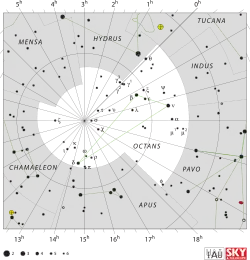Gamma3 Octantis
Gamma3 Octantis, Latinized from γ3 Octantis, is a solitary star[12] located in the southern circumpolar constellation Octans. It is faintly visible to the naked eye as an orange-hued star with an apparent magnitude of 5.28.[2] The object is located relatively close at a distance of 264 light years but is receding with a heliocentric radial velocity of 15 km/s. At its current distance, Gamma3 Octantis' brightness is diminished by two tenths of a magnitude due to interstellar dust[13] and Eggen (1993) lists it as a member of the old disk population.[14] It has an absolute magnitude of +0.83.[7]
 | |
| Observation data Epoch J2000.0 Equinox J2000.0 (ICRS) | |
|---|---|
| Constellation | Octans |
| Right ascension | 00h 10m 02.17249s[1] |
| Declination | −82° 13′ 26.5695″[1] |
| Apparent magnitude (V) | 5.28±0.01[2] |
| Characteristics | |
| Evolutionary stage | Horizontal branch[3] |
| Spectral type | K1/2 III[4] |
| U−B color index | +0.92[5] |
| B−V color index | +1.05[5] |
| Astrometry | |
| Radial velocity (Rv) | 15±2.8[6] km/s |
| Proper motion (μ) | RA: −22.050 mas/yr[1] Dec.: −20.218 mas/yr[1] |
| Parallax (π) | 12.3535 ± 0.0517 mas[1] |
| Distance | 264 ± 1 ly (80.9 ± 0.3 pc) |
| Absolute magnitude (MV) | +0.83[7] |
| Details[8] | |
| Mass | 2.23±0.09 M☉ |
| Radius | 9.94±0.24 R☉ |
| Luminosity | 50.5±1.2 L☉ |
| Surface gravity (log g) | 2.78±0.15 cgs |
| Temperature | 4,879±51 K |
| Metallicity [Fe/H] | +0.19±0.04 dex |
| Rotational velocity (v sin i) | <1[9] km/s |
| Other designations | |
| Database references | |
| SIMBAD | data |
Gamma3 Octantis has a stellar classification of K1/2 III,[4] indicating that it is an evolved K-type star with the characteristics of a K1 and K2 giant star. It is a red clump star that is currently on the horizontal branch,[3] fusing helium at its core. At present it has 2.23 times the mass of the Sun but has expanded to almost 10 times its girth.[8] It radiates 50.5 times the luminosity of the Sun from its enlarged photosphere at an effective temperature of 4,879 K, which gives it a yellowish-orange glow.[8] Gamma3 Octantis is metal enriched with an iron abundance 1.55[8] times that of the Sun and common for giant stars, spins slowly with a projected rotational velocity less than 1 km/s.[9]
References
- Vallenari, A.; et al. (Gaia collaboration) (2023). "Gaia Data Release 3. Summary of the content and survey properties". Astronomy and Astrophysics. 674: A1. arXiv:2208.00211. Bibcode:2023A&A...674A...1G. doi:10.1051/0004-6361/202243940. S2CID 244398875. Gaia DR3 record for this source at VizieR.
- Høg, E.; Fabricius, C.; Makarov, V. V.; Urban, S.; Corbin, T.; Wycoff, G.; Bastian, U.; Schwekendiek, P.; Wicenec, A. (March 2000). "The Tycho-2 catalogue of the 2.5 million brightest stars". Astronomy and Astrophysics. 355: L27–L30. Bibcode:2000A&A...355L..27H. ISSN 0004-6361.
- Laney, C. D.; Joner, M. D.; Pietrzyński, G. (11 November 2011). "A new Large Magellanic Cloud K-band distance from precision measurements of nearby red clump stars". Monthly Notices of the Royal Astronomical Society. 419 (2): 1637–1641. arXiv:1109.4800. Bibcode:2012MNRAS.419.1637L. doi:10.1111/j.1365-2966.2011.19826.x. ISSN 0035-8711.
- Houk, N.; Cowley, A. P. (1975). University of Michigan Catalogue of two-dimensional spectral types for the HD stars. Volume I. Declinations −90° to −53°. Bibcode:1975mcts.book.....H.
- Johnson, H. L.; Mitchell, R. I.; Iriarte, B.; Wisniewski, W. Z. (1966). "UBVRIJKL Photometry of the Bright Stars". Communications of the Lunar and Planetary Laboratory. 4: 99–110. Bibcode:1966CoLPL...4...99J.
- Gontcharov, G. A. (November 2006). "Pulkovo Compilation of Radial Velocities for 35 495 Hipparcos stars in a common system". Astronomy Letters. 32 (11): 759–771. arXiv:1606.08053. Bibcode:2006AstL...32..759G. doi:10.1134/S1063773706110065. eISSN 1562-6873. ISSN 1063-7737. S2CID 119231169.
- Anderson, E.; Francis, Ch. (May 2012). "XHIP: An extended hipparcos compilation". Astronomy Letters. 38 (5): 331–346. arXiv:1108.4971. Bibcode:2012AstL...38..331A. doi:10.1134/S1063773712050015. eISSN 1562-6873. ISSN 1063-7737. S2CID 119257644.
- Ottoni, G.; Udry, S.; Ségransan, D.; Buldgen, G.; Lovis, C.; Eggenberger, P.; Pezzotti, C.; Adibekyan, V.; Marmier, M.; Mayor, M.; Santos, N. C.; Sousa, S. G.; Lagarde, N.; Charbonnel, C. (January 2022). "CORALIE radial-velocity search for companions around evolved stars (CASCADES): I. Sample definition and first results: Three new planets orbiting giant stars". Astronomy & Astrophysics. 657: A87. arXiv:2201.01528. Bibcode:2022A&A...657A..87O. doi:10.1051/0004-6361/202040078. eISSN 1432-0746. ISSN 0004-6361.
- De Medeiros, J. R.; Alves, S.; Udry, S.; Andersen, J.; Nordström, B.; Mayor, M. (January 2014). "A catalog of rotational and radial velocities for evolved stars V: Southern Stars⋆⋆⋆". Astronomy & Astrophysics. 561: A126. arXiv:1312.3474. Bibcode:2014A&A...561A.126D. doi:10.1051/0004-6361/201220762. eISSN 1432-0746. ISSN 0004-6361.
- Gould, Benjamin Apthorp (1878). "Uranometria Argentina : brillantez y posicion de las estrellas fijas, hasta la septima magnitud, comprendidas dentro de cien grados del polo austral : con atlas". Resultados del Observatorio Nacional Argentino. 1. Bibcode:1879RNAO....1.....G.
- "gam03 Octantis". SIMBAD. Centre de données astronomiques de Strasbourg. Retrieved 21 February 2022.
- Eggleton, P. P.; Tokovinin, A. A. (11 September 2008). "A catalogue of multiplicity among bright stellar systems". Monthly Notices of the Royal Astronomical Society. 389 (2): 869–879. arXiv:0806.2878. Bibcode:2008MNRAS.389..869E. doi:10.1111/j.1365-2966.2008.13596.x. eISSN 1365-2966. ISSN 0035-8711. S2CID 14878976.
- Gontcharov, George A.; Mosenkov, Aleksandr V. (28 September 2017). "Verifying reddening and extinction for Gaia DR1 TGAS main sequence stars". Monthly Notices of the Royal Astronomical Society. 472 (4): 3805–3820. arXiv:1709.01160. Bibcode:2017MNRAS.472.3805G. doi:10.1093/mnras/stx2219. eISSN 1365-2966. ISSN 0035-8711.
- Eggen, O. J. (July 1993). "Evolved GK stars near the sun. I - The old disk population". The Astronomical Journal. 106: 80. Bibcode:1993AJ....106...80E. doi:10.1086/116622.